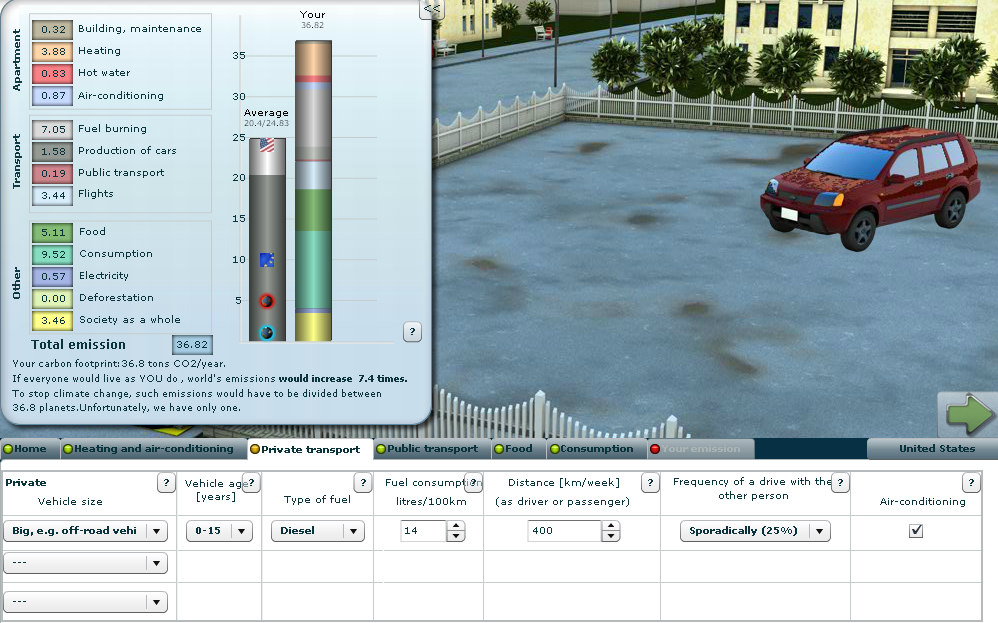
When I learned for the first time that an average European is responsible for emissions of almost 10 tons of carbon dioxide per year (and an American double that amount) I was really shocked.
I wanted to know how much of this carbon footprint is related to particular activities: heating, riding a car, flying a plane, food and goods production, home electricity consumption etc. I wanted to know how my carbon footprint relates to the average in my country, in the United States, China or India. Was my emissions level safe for the Earth or maybe it looked like the trace of Godzilla? And most of all – I wanted to know what changes in my life will have a real impact, not just improve my good feeling. I strived to reduce my carbon footprint, so this information was critical for informed decisions.
If you have similar thoughts, the best way to answer them is to use a Personal Carbon Footprint Calculator, official tool of Polish Ministry of Environment for UN COP14 climate conference (there is also a local version of the calculator - you can download it here, installing Adobe AIR first). The calculator will translate your lifestyle into your total carbon footprint, divided into several categories and displayed in a clear graphical form.
Illustration 1. American lifestyle: double average US income, suburban house, SUV, meat diet and frequent flying amount to 37 tons of CO2 emissions a year.
The calculator also shows how your carbon footprint would change after some changes to your lifestyle.
Illustration 2. American lifestyle reconsidered: half of average US income, city apartment, bicycle and public transport, local vegetarian diet and no flying reduce the footprint to 9 tons of CO2 per year. Excluding the emissions one does not control (bottom yellow bar, representing emission related to the construction and maintenance of roads, tunnels and bridges, lighting the cities, administration, army and police, rescue services, clinics and hospitals, churches, museums, water supply and wastewater systems, schools etc.) the personal emissions is reduced to just over 5 tons CO2/year.
Check your emissions and see, what can you do to lower your carbon footprint. Make an experiment: see what changes to your lifestyle would be needed to reduce your footprint to the world’s average (5 tons CO2/year). For me it was a very enlightening experience.
I realized how many sources of emissions there are and that living in a developed country it’s really hard to reduce the emissions - there is no single silver bullet. I also realized that in my efforts to reduce my carbon footprint I was often fooling myself, doing what was easy, not what was effective.
I often use the calculator during my lectures and workshops. I usually simulate a person living an 'American Lifestyle' (say, Mr Jones) and then ask workshop participants to advice, what should Mr Jones do to significantly reduce his footprint. First suggestion usually is an energy-efficient house. Then things get tricky, because people feel Mr Jones would not necessarily like their suggestions: give up flying, don’t use a car (or sell your SUV and buy something smaller and much more energy efficient – and drive less!), curb your consumption, stop eating meat, take showers instead of baths and don’t use air conditioning.
Mr Jones, willing to preserve both his high consumption lifestyle and an image of a good and responsible citizen, may be tempted to forget the whole issue switching to another topics, denying the problem or saying that his emissions are only an insignificantly small part of the problem (or use a number of other well-known justifications for not-changing-anything).
I wondered about it a lot and decided that doing my best to limit the "height of the carbon footprint bar" is the right thing to do (now it’s around 5.8 tons CO2/year). There are a few reasons, why:
So, in my opinion, we should reduce our footprint chiefly not because it reduces the fossil fuels consumption, but because it helps us embrace the issue, encourages self-education, changes our world view, stimulates cultural changes around us and influences public outlook and policies.
Living a low-carbon life in an industrialized country is not easy. Moreover, reducing one’s emissions under 1 ton CO2/year (recommended until 2050) under current infrastructure is next to impossible. We have to redevelop it. The calculator lets you check your impact on the planet given other sources of energy, changes in industry and transport.
But do not wait until it happens by itself. Reducing your own footprint you will stimulate the transition. Sticking to the old ways you maintain the status quo.
Posted by Marcin Popkiewicz on Tuesday, 29 April, 2014
 |
The Skeptical Science website by Skeptical Science is licensed under a Creative Commons Attribution 3.0 Unported License. |